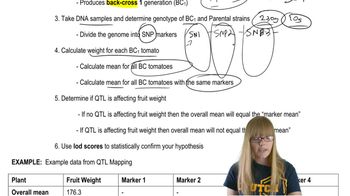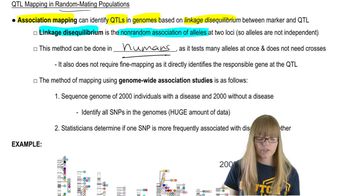Table of contents
- 1. Introduction to Genetics51m
- 2. Mendel's Laws of Inheritance3h 37m
- 3. Extensions to Mendelian Inheritance2h 41m
- 4. Genetic Mapping and Linkage2h 28m
- 5. Genetics of Bacteria and Viruses1h 21m
- 6. Chromosomal Variation1h 48m
- 7. DNA and Chromosome Structure56m
- 8. DNA Replication1h 10m
- 9. Mitosis and Meiosis1h 34m
- 10. Transcription1h 0m
- 11. Translation58m
- 12. Gene Regulation in Prokaryotes1h 19m
- 13. Gene Regulation in Eukaryotes44m
- 14. Genetic Control of Development44m
- 15. Genomes and Genomics1h 50m
- 16. Transposable Elements47m
- 17. Mutation, Repair, and Recombination1h 6m
- 18. Molecular Genetic Tools19m
- 19. Cancer Genetics29m
- 20. Quantitative Genetics1h 26m
- 21. Population Genetics50m
- 22. Evolutionary Genetics29m
20. Quantitative Genetics
QTL Mapping
Problem 21
Textbook Question
A 3-inch plant was crossed with a 15-inch plant, and all F₁ plants were 9 inches. The F₂ plants exhibited a 'normal distribution,' with heights of 3, 4, 5, 6, 7, 8, 9, 10, 11, 12, 13, 14, and 15 inches.
What will be the outcome if the F₁ plants are testcrossed with plants that are homozygous for all nonadditive alleles?
 Verified step by step guidance
Verified step by step guidance1
<span>Identify the genetic basis of the trait: The problem suggests a quantitative trait, as indicated by the normal distribution of plant heights in the F₂ generation. This implies polygenic inheritance, where multiple genes contribute to the phenotype.</span>
<span>Understand the F₁ generation: The F₁ plants are all 9 inches tall, which is the average of the parental heights (3 inches and 15 inches). This suggests that the F₁ plants are heterozygous for the alleles contributing to plant height.</span>
<span>Define the testcross: A testcross involves crossing the F₁ plants with a plant that is homozygous for all nonadditive alleles. In this context, nonadditive alleles are those that do not contribute to the increase in plant height.</span>
<span>Predict the outcome of the testcross: Since the testcross involves crossing heterozygous F₁ plants with homozygous recessive plants, the offspring will exhibit a range of phenotypes. The distribution of these phenotypes will depend on the number of contributing alleles inherited from the F₁ plants.</span>
<span>Consider the phenotypic distribution: The offspring of the testcross will likely show a range of heights, but the average height will be lower than that of the F₁ generation, as the homozygous recessive parent contributes no alleles that increase height.</span>
Recommended similar problem, with video answer:
 Verified Solution
Verified SolutionThis video solution was recommended by our tutors as helpful for the problem above
Video duration:
2mPlay a video:
Was this helpful?
Key Concepts
Here are the essential concepts you must grasp in order to answer the question correctly.
Quantitative Traits
Quantitative traits are characteristics that are influenced by multiple genes and exhibit a continuous range of phenotypes, such as height. In this case, the plant heights show a normal distribution, indicating that multiple alleles contribute to the trait, resulting in a variety of heights in the F₂ generation.
Recommended video:
Guided course

Traits and Variance
Testcross
A testcross is a genetic cross between an individual with an unknown genotype and a homozygous recessive individual. This method helps determine the genotype of the unknown individual by analyzing the phenotypes of the offspring. In this scenario, crossing the F₁ plants with homozygous nonadditive alleles will reveal the genetic contributions of the F₁ plants.
Additive vs. Nonadditive Alleles
Additive alleles contribute to the phenotype in a cumulative manner, while nonadditive alleles do not follow this pattern and can mask the effects of other alleles. In the context of the question, crossing F₁ plants with homozygous nonadditive alleles will help clarify how these alleles influence the resulting plant heights and the overall distribution of traits in the offspring.
Recommended video:
Guided course

New Alleles and Migration
Related Videos
Related Practice





